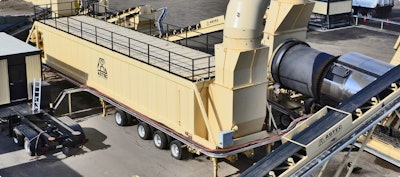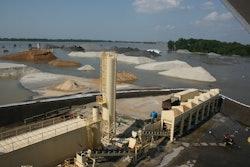
As everyone knows, the purpose of a baghouse is to remove the fines entrained in the airstream from our drum before we emit that air to the atmosphere. Various state regulatory agencies have written specifications regulating how much dust we can release each year. As plant operators, it is our responsibility to ensure that we are not exceeding those limitations.
Your eyes are one of your most valuable tools in gauging the efficiency of that cleaning process. If you look at your exhaust stack and you can see dust in the airstream then you know that there is a problem. Polarizing sunglasses are very helpful to see any dust in your stack. In essence, they highlight the dust. If you see any dust you need to immediately schedule a visualite test to see where the leaks are. Any dust leaks should be addressed immediately.
Proper daily operations of a pulse jet baghouse are as follows:
- 80 - 90 psi. of mainline air pressure.
- Pulse interval time should be set to maintain 3-in. to 5-in. of Delta ‘P’ (pressure drop)
- Pulse “on” duration should be set for minimum “trail” (after flow of air on solenoid close)
Proper daily operations of a rotary baghouse are as follows:
- Rotor speed should be set to maintain 3-in. to 5-in. of Delta ‘P’ (pressure drop)
In my opinion, the closer you run to 5-in. of Delta ‘P’ the better it is for the bags. With both systems, the draught through the drum should be maintained between .1-in. and .2-in. The primary goal is to keep enough draught to minimize puffing at the drum. This is simply an indication that we are maintaining a positive suction in our drum at all times. As we all know, too much suction carries proportionally larger quantities of smaller sized aggregate from the drum to the baghouse causing unnecessary wear and messing with our gradations.
Shut Down Procedure Matters
The most confusion in baghouse operations has always been centered around the proper shut down procedure at the end of the day. The proper procedure for shut down is as follows:
- End the process in your blending computer.
- When the AC DIVERTS kill the pulsars/rotors.
- Reverse the AC Pump and open the AC valve to clean out drum line. Turn on pulsars/rotors.
- Run AC Pump in reverse for about 2 minutes, then kill it along with the pulsars/rotors.
- Leave ALL augers running until the plant is cleaned out.
- Kill everything in reverse sequence of start-up.
This is how the baghouse should be operated. So let’s examine the things that go wrong when the baghouse is shut down incorrectly.
Leave Pulsars/Rotors on Too Long
The most common problem associated with this is that there is a long LAG until you start to get fines for the mix on start-up. You get a lot of “marbles” on start-up. In other words- waste.
Additionally, your bags should have a layer of “cake” on them to keep the high velocity dust particles from impacting directly on the cloth which can significantly shorten bag life.
Shut Pulsars/Rotors off Too Soon
The most common problem with this is that you get a surge of dust in your mix when you first start up in the morning. This means more waste and possibly contaminated mix in the silo. A HEAVY surge of dust could potentially stall the augers, ending production for hours.
All asphalt plants have their own little quirks. I adjust the amount of time I leave the pulsars/rotors on to fit the operational circumstances of the plant I am running. Perhaps you will need to leave your baghouse cleaning out for a bit longer. Maybe another minute or two.
My advice is don’t be bashful. Find what works best at your plant, but I guarantee you it will not be very far from what I am describing. I have operated several HUNDRED plants and this is the system I have developed over the last 49 years with many brands of asphalt plants on 6 continents from Australia to the Arctic Circle, from Oregon to Russia.



















